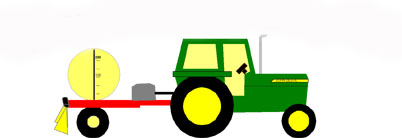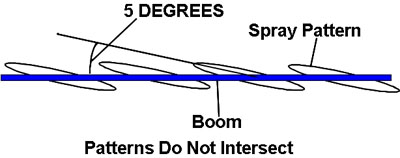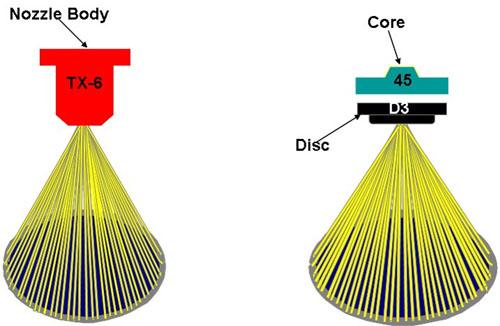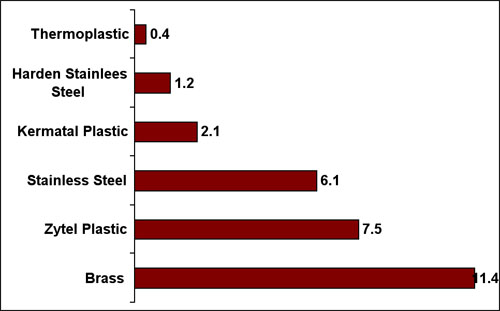
Introduction
Nozzle selection is one of the most important decisions to be made related to pesticide applications. The type of nozzle affects not only the amount of spray applied to a particular area, but also the uniformity of the applied spray, the coverage obtained on the sprayed surfaces, and the amount of drift that can occur. Each nozzle type has specific characteristics and capabilities and is designed for use under certain application conditions. The types which are commonly used for ground application of agricultural chemicals are flat-fan, even flat-fan, and cone nozzle.
Regular flat-fan nozzles are used for most broadcast spraying of herbicides and for certain insecticides when foliar penetration and coverage are not required. These nozzles produce a flat oval spray pattern with tapered edges (Figure 1). They are available in spray-fan angles of 65, 80, and 110 degrees and are usually spaced 20 inches apart on the boom at a height of 15-24 inches.
 Figure 1. Flat Fan Nozzles angled 5 degrees from the boom.
Figure 1. Flat Fan Nozzles angled 5 degrees from the boom.The normal recommended operating pressure for regular flat-fan nozzles is 20 to 30 psi. At these pressures, this nozzle type will produce medium to coarse drops that are not as susceptible to drift as the finer drops produced at pressures of 40 psi or greater. At these higher pressures, the possibility of drift increases significantly so appropriate precautions must be taken to minimize its effects.
Extended-range flat-fan nozzles vary the droplet size and flow rate by alternating pressures. It holds its pattern at a low pressure (15 psi), ensuring uniform coverage along the boom. Extended-range flat-fan nozzles are available in both 80 and 110 degree fan angles. For soil applications, the recommended pressure range is from 10 to 30 psi. Smaller drops are produced at pressures from 30 to 60 psi, increasing the likelihood of drift. High pressures should be used only to apply foliar pesticides that must penetrate into the plant canopy or that require maximum coverage. Spray drift is a major concern at pressures above 40 psi.
Drift-reduction pre-orifice nozzles produce a standard flat-fan pattern while effectively lowering the exit pressure at the nozzle. The lowered exit pressure creates a larger droplet spectrum with less driftable fines, minimizing the off-target movement of the spray pattern.
Two styles of drift reduction flat-spray nozzles are currently available. The RF Raindrops® flat spray nozzle is available with a 105 to 115 degree fan angle, and the Drift Guard® flat spray nozzle is available in both 80 and 110 degree fan angles. With a larger droplet size, drift reduction pre-orifice nozzles can replace conventional flat-fan 80 and 110 degree tips in broadcast applications where spray drift is a problem. The recommended pressure for this nozzle is 30 to 60 psi. An alternative to the pre-orifice nozzle is using a larger extended range flat-fan nozzle operated at a lower pressure.
Turbo® flat-fan nozzles are designed to produce less turbulence within the nozzle body thus causing less wear and longer life. These nozzles produce large droplets that will not drift. This nozzle is available in 110 degree fan angle.
Overlap of flat-fan nozzles is required because the outer edges of the spray patterns have tapered or reduced volumes. The most uniform pattern is achieved when this overlap is 50 to 60 percent of the nozzle spacing (Figure 2). Table 1 list suggested nozzle heights for the various spray angles. Check spray overlap by spraying clean water onto a flat surface (concrete) and observing drying patterns. Because of their ability to produce a very uniform pattern when correctly overlapped, the flat-fan nozzle type is generally the best choice for the broadcast application of herbicides.
 Figure 2. Nozzle overlap for flat fans.
Figure 2. Nozzle overlap for flat fans.
| Table 1. Various nozzle heights for a 20-inch spacing. | |
|
Spray Angle (degrees)
|
Nozzle Height (inches)
|
|
65
|
22-24
|
|
80
|
17-19
|
|
110
|
15-18
|
Even flat-fan nozzles apply uniform coverage across the entire width of the spray pattern (Figure 3). This type of nozzle is used for banding chemicals over the row. The recommended operating pressure for even flat-fan nozzles is between 20 and 30 psi. The width of the band produced is determined by nozzle height. The band widths produced for various nozzle heights are shown in Table 2.
| Table 2. Nozzle hieght for 80- and 90-degree even flat-fan nozzles in inches. | ||
|
Band Width (inches)
|
80 degree
|
95 degree
|
|
8
|
5
|
4
|
|
10
|
6
|
5
|
|
12
|
7
|
6
|
|
14
|
8
|
7
|
 Figure 3. Even flat fan procedures uniform spray deposition.
Figure 3. Even flat fan procedures uniform spray deposition.
Cone nozzles are used primarily when plant foliage penetration is essential for effective insect or disease control and when drift is not a major concern. At pressures of 40 to 80 psi, these nozzles produce small droplets that readily penetrate plant canopies and cover the underside of the leaves more effectively than any other nozzle type. However, because of the small droplets produced and high operating pressures, these nozzles produce patterns which are very susceptible to drift and should therefore never be used with any chemical for which drift can cause a problem. They also are very difficult to arrange along a boom for uniform distribution and are therefore not recommended for broadcasting herbicides.
The two common styles of cone nozzles available are the solid-cone and hollow-cone. The solid-cone nozzle produces a cone-shaped pattern with a uniform distribution of chemical throughout the pattern. The hollow-cone nozzles produce a cone-shaped pattern with the spray concentrated in a ring around the outer edge of the pattern (Figure 4).
 Figure 4. Hollow Cone Nozzles - Nozzle Body and Disc-n-Core.
Figure 4. Hollow Cone Nozzles - Nozzle Body and Disc-n-Core.
Nozzle Control
Various types of nozzle bodies and caps, including color coded versions, and multiple nozzle bodies are available with threads as well as quick-attaching adapters. Nozzle tips are interchangeable in the cap and are available in a wide variety of materials, including hardened stainless steel, stainless steel, brass, ceramic, and various types of plastic. Hardened stainless steel and ceramic are the most wear-resistant materials but are also the most expensive. Stainless steel tips, with corrosive or abrasive materials, have excellent wear resistance. Plastic tips are resistant to corrosion and abrasion and are proving to be very economical for applying pesticides. Brass tips have been common but wear rapidly when used to apply abrasive materials such as wettable powders and are corroded by some liquid fertilizers. Brass tips are economical for limited use, but other types should be considered for more extensive use. Figure 5 shows the increase in flow rate of spraying an abrasive material over a set period of time.
| Table 3. Suggested application for selecting the proper nozzle type for most spraying applications. 1 - Excellent, 2 - Very Good, and 3 - Good. | ||||||||||
|
Pre-Emerge Herbicide
|
Post-Emerge Herbicide
|
Insecticides - Fungicides
|
||||||||
| Type | Soil Incorp | Band | Broadcast | Contact Band | Contact Broadcast | Systemic Band | Systemic Broadcast | Soil Incorp | Band | Broadcast |
| Regular Flat Fan (8003)* |
2
|
2
|
2
|
2
|
2
|
2
|
||||
| Ext. Range Flat Fan (XR9004 and 80-4R) |
1
|
2
|
1
|
2
|
||||||
| Drift Control Flat Fan (DG8002 and RF2) |
1
|
1
|
2
|
1
|
1
|
|||||
| Turbo Flan Fan (TT11002) |
1
|
1
|
2
|
1
|
1
|
|||||
| Air-Assist Fan (TDXL-11003, AI11003, Raindrop Ultra 3) |
1
|
1
|
1
|
1
|
1
|
|||||
| Flood (TK-2 and D 2) |
2
|
3
|
2
|
2
|
2
|
|||||
| Turbo Flood (TF-VS4) |
1
|
1
|
1
|
1
|
||||||
| Wide Angle Full Cone (FL-8 and RA-8) |
3
|
2
|
2
|
3
|
||||||
| Even Fan (8004E) |
1
|
2
|
1
|
2
|
||||||
| Twin Flat Fan (TJ60-8003) |
1
|
1
|
1
|
|||||||
| Hollow Cone (TX-6, HC 6, D 4-23 and DC 4-23) |
1
|
1
|
||||||||
| *Examples of nomenclature for "Spraying Systems" nozzles. | ||||||||||
 Figure 5. Percent increase in nozzle flow rate of flat-fan spray.
Figure 5. Percent increase in nozzle flow rate of flat-fan spray.
Selecting the Nozzle Tip
The correct nozzle tip size depends on an application rate in gallons per acre (GPA), ground speed (MPH), and effective spray width of each nozzle (W). The best method for choosing the correct nozzle tip size is to determine the gallons per minute (GPM) of nozzle output required and then select a nozzle tip size that, when operated within the recommended pressure range, will provide this flow rate. Avoid relying on the "gallons per acre" rating which some manufacturers give their nozzles as means of selecting nozzle tip size. This rating is correct only for standard conditions (usually 30 psi, 4 MPH, and 20-inch nozzle spacings). The gallon per acre rating is useless if any variance from the standard occurs. By following the steps described below, the proper nozzle tip size can be selected.
1. Determine "GPA " - First select the application rate in gallons per acre (GPA) used. The application rate consists of the gallons of carrier (water, fertilizer, etc.) plus chemical applied per treated acre. The best guides for this decision are the recommended ranges listed on the label, the recommendation of a chemical dealer or county agricultural agent, and experience with that particular chemical.
2. Determine "MPH" - Select an appropriate ground speed in miles per hour (MPH) for the field to be sprayed. Experience is the best guide here. Generally, speeds between three and 7 MPH are considered appropriate for ground sprayers. Do not rely solely on speedometers as an accurate measure of ground speed, especially on older tractors. Slippage and variation in tire sizes can result in speedometer errors of 30 percent or more. Ground speed can be determined by the following equation:

3. Determine "W" - Determine the effective sprayed width per nozzle (W) in inches. For broadcast spraying, W = nozzle spacing, For band spraying, W = band width, For row crop application, such as spraying for directed spraying, W = row spacing.
4. Determine Tip Size - Once the application rate, ground speed, and spray width per nozzle have been determined, the flow rate required for each nozzle in gallons per minute (GPM) can be determined by using a nozzle catalog, tables or the following equation:

Example: A herbicide is to be broadcast at 20 GPA at a speed of 5 MPH, using flat fan nozzles spaced 20 inches apart on the boom. What size nozzle tip should be selected?
The required flow rate for each nozzle is as follows:


The nozzle selected must have a flow rate of 0.34 GPM when operated within the recommended pressure range of a flat-fan nozzle (20 to 30 psi). By checking nozzle catalogs, you will find a number of different brands of flooding flat fan nozzles which will provide this flow rate. For example, the Spraying Systems XR8004 and Delavan LFR80-4R nozzles have a rated output of 0.35 GPM at 30 psi. Either of these nozzles will be sufficient for this application.
Example: A foliar fungicide is to be applied at 15 GPA at a speed of 7 MPH, using hollow cone nozzles. The row spacing is 36 inches with three nozzles directed toward each row. What size tip should be selected?
The required flow rate for each row is as follows:


The flow rate for each nozzle is the row (GPM) divided by the number of tips per row.

The nozzle selected must have a flow rate of 0.21 GPM operating between 40 to 80 psi. Checking nozzle catalogs, the Spray Systems TX-4 and Delavan HC-4 cone spray nozzles have a rated output of 0.20 GPM at 60 psi. Or the Spray System D 4-23 and Delavan DC 4-23 disc-core nozzles have a rated output of 0.21 GPM at 80 psi. Either one of the nozzles chosen would deliver the proper amount per acre.
Type of Diluent
The diluent (diluting agent) for most spray applications is water. However, your situation may require the use of another diluent. The pesticide labeling usually recommends the diluent to be used with that product. You must know what diluent you will use before you can select the appropriate nozzles for the job.
Because most selection charts provided by nozzle manufacturers are based on spraying with water, the figures will not be correct if you are using another diluent. A table such as Table 4 is often provided to help you adjust the figures to fit your situation.
Multiply the values on the nozzle charts by the conversion factor from the table to determine the correct value for the solution being sprayed.
| Table 4. Diluent Conversion Factors. | ||
|
Weight of Solution (lbs/gal.)
|
Specific Gravity
|
Conversion Factor
|
|
6.6 (kerosene)
|
0.79
|
0.89
|
|
7.0
|
0.84
|
0.92
|
|
8.0
|
0.96
|
0.98
|
|
8.34 (water)
|
1.00
|
1.00
|
|
9.0
|
1.08
|
1.04
|
|
10.0
|
1.20
|
1.10
|
|
10.65 (28% N)
|
1.28
|
1.13
|
|
11.0
|
1.32
|
1.15
|
|
12.0
|
1.44
|
1.20
|
|
14.0
|
1.68
|
1.30
|
|
16.0
|
1.92
|
1.39
|
Example: You have determined that you would be applying 15 gallons per acre of a 28% nitrogen solution with a flat fan nozzle at a speed of 5 MPH. The nozzle spacing is 20 inches. The nozzle to select from the catalogs (based on water) would be calculated as follows:
15 GPA (28% N) x 1.13 (conversion factor from Table 4) = 16.95 GPA (water)


The nozzle selected must have a flow rate of 0.285 GPM when operated within the recommended pressure range of a flat-fan (20 to 30 psi). Checking the catalogs, Spraying Systems XR8004 and Delavan LFR80-4R nozzles have a rated output of 0.28 GPM at 20 psi.
There are different diluents used for spray application. A conversion factor for a weight of solution not shown in Table 3 can be determined by the following procedure.
1. Determine the weight of solution (pounds per gallon). Measure out a gallon of diluent in a container. Weigh the container plus diluent in pounds. Subtract the weight of the container. Your supply dealer can also provide this information.
2. Determine the specific gravity (SG) of the solution. Divide the weight of solution/gallon by the weight of water/gallon.

3. Next, calculate the conversion factor by taking the square root of the specific gravity.

This conversion factor can then be used in the equation stated previously.
Calibration
Calibration is a method of determining the amount of spray volume applied per acre. Sprayers should be calibrated to determine the amount of mixture that is actually being applied per acre.
Status and Revision History
Published on Aug 15, 2005
Published on Feb 23, 2009
Published on May 14, 2009
Published with Full Review on Feb 09, 2012
